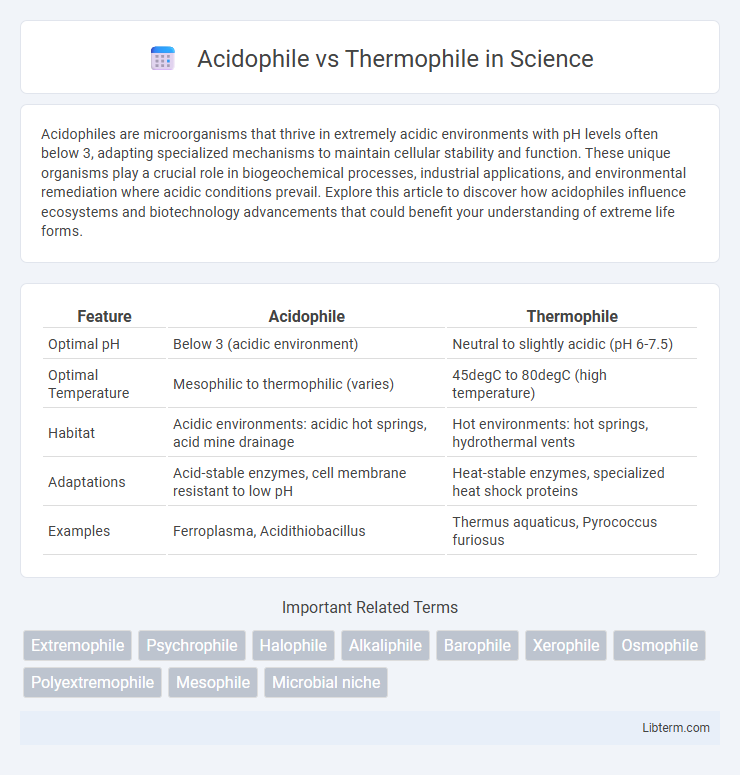Acidophiles are microorganisms that thrive in extremely acidic environments with pH levels often below 3, adapting specialized mechanisms to maintain cellular stability and function. These unique organisms play a crucial role in biogeochemical processes, industrial applications, and environmental remediation where acidic conditions prevail. Explore this article to discover how acidophiles influence ecosystems and biotechnology advancements that could benefit your understanding of extreme life forms.
Table of Comparison
| Feature | Acidophile | Thermophile |
|---|---|---|
| Optimal pH | Below 3 (acidic environment) | Neutral to slightly acidic (pH 6-7.5) |
| Optimal Temperature | Mesophilic to thermophilic (varies) | 45degC to 80degC (high temperature) |
| Habitat | Acidic environments: acidic hot springs, acid mine drainage | Hot environments: hot springs, hydrothermal vents |
| Adaptations | Acid-stable enzymes, cell membrane resistant to low pH | Heat-stable enzymes, specialized heat shock proteins |
| Examples | Ferroplasma, Acidithiobacillus | Thermus aquaticus, Pyrococcus furiosus |
Introduction to Acidophiles and Thermophiles
Acidophiles are microorganisms that thrive in extremely acidic environments with pH levels below 3, often found in acidic hot springs, sulfuric pools, or acid mine drainage. Thermophiles are heat-loving microbes that grow optimally at temperatures between 41degC and 122degC, commonly inhabiting geothermal areas such as hot springs and hydrothermal vents. Both acidophiles and thermophiles possess specialized enzymes and cellular structures enabling survival and metabolic activity under extreme pH and temperature conditions respectively.
Defining Extremophiles: Acidophiles vs Thermophiles
Extremophiles are microorganisms adapted to thrive in extreme environmental conditions, with acidophiles favoring highly acidic environments typically below pH 3, such as sulfur-rich hot springs and acid mine drainages. Thermophiles inhabit extremely high temperatures, often between 45degC and 122degC, commonly found in geothermal environments like hydrothermal vents and hot springs. The distinct cellular mechanisms of acidophiles include proton pump regulation for acid resistance, while thermophiles exhibit heat-stable enzymes and membrane adaptations essential for survival in thermal extremes.
Unique Habitats: Where Acidophiles and Thermophiles Thrive
Acidophiles uniquely inhabit environments with extreme acidity, such as sulfuric hot springs and acid mine drainage sites, where pH levels often drop below 3. Thermophiles thrive in high-temperature habitats like geothermal vents and hydrothermal springs, enduring temperatures from 45degC to over 80degC. These specialized niches showcase adaptations to extreme pH and temperature conditions, respectively, highlighting their ecological and biochemical diversity.
Cellular Adaptations: Surviving Acidic vs High-Temperature Environments
Acidophiles possess cellular adaptations such as highly impermeable membranes and specialized proton pumps to maintain intracellular pH homeostasis in extremely acidic environments. Thermophiles exhibit thermostable enzymes with enhanced hydrogen bonding and chaperone proteins that prevent protein denaturation at high temperatures. Both groups modify lipid membrane composition to optimize fluidity and integrity, ensuring survival under harsh pH or thermal stress conditions.
Metabolic Pathways: Comparing Energy Generation
Acidophiles generate energy primarily through acid-stable enzymes enabling efficient proton gradients in highly acidic environments, often utilizing sulfur or iron oxidation pathways. Thermophiles rely on heat-stable enzymes to drive metabolic pathways such as chemolithotrophy or heterotrophy at high temperatures, optimizing ATP production and electron transport chains under thermal stress. Both extremophiles exhibit specialized metabolic adaptations that allow energy generation under acid or heat extremes, with unique cofactors and membrane compositions enhancing electron flow and substrate utilization.
Industrial Applications of Acidophiles and Thermophiles
Acidophiles play a crucial role in bioleaching processes in mining industries by extracting valuable metals like copper and gold from ores through their ability to thrive in low pH environments. Thermophiles are extensively used in industrial biotechnology for the production of thermostable enzymes such as amylases and proteases, which enhance efficiency in processes like biofuel production, waste treatment, and food processing. Both microorganisms contribute to bioremediation, with acidophiles facilitating heavy metal removal and thermophiles accelerating the degradation of organic pollutants at elevated temperatures.
Genetic Diversity and Evolutionary Insights
Acidophiles and thermophiles exhibit distinct genetic adaptations that enable survival in extreme pH and temperature environments, respectively, reflecting high genetic diversity within their domains. Genomic analyses reveal unique gene clusters responsible for acid resistance in acidophiles and heat-stable enzymes in thermophiles, highlighting convergent evolutionary strategies. Comparative genomics provides insights into horizontal gene transfer events and evolutionary pressures shaping these extremophiles' genomes, offering valuable models for studying molecular evolution and biotechnological applications.
Ecological Roles in Natural Environments
Acidophiles thrive in highly acidic environments like sulfur springs and acid mine drainages, playing a crucial role in bioleaching and nutrient cycling by oxidizing sulfur and iron compounds. Thermophiles inhabit extreme heat environments such as hot springs and hydrothermal vents, driving organic matter decomposition and supporting chemosynthetic microbial communities in these high-temperature ecosystems. Both groups contribute significantly to biogeochemical processes, influencing ecosystem stability and nutrient availability in their respective extreme habitats.
Challenges in Studying Acidophiles and Thermophiles
Studying acidophiles presents challenges due to their requirement for extremely low pH environments, which can degrade standard laboratory materials and impair experimental reproducibility, while thermophiles demand sustained high-temperature conditions that complicate the maintenance of stable cultures and molecular analyses. Both acidophiles and thermophiles exhibit unique protein adaptations to maintain stability and function under extreme acidity or heat, complicating the characterization of their enzymatic mechanisms using conventional biochemical assays. Additionally, isolating pure cultures from extreme acidic or thermal habitats is inherently difficult because of complex microbial communities and the need for precise replication of natural environmental stresses in vitro.
Future Research and Biotechnological Potential
Future research into acidophiles and thermophiles aims to unlock novel enzymes capable of functioning in extreme pH and temperature conditions, with significant implications for industrial biocatalysis and environmental remediation. Exploring the genetic and metabolic pathways of these extremophiles can enhance the development of robust biofuels, pharmaceuticals, and biomaterials. Advanced biotechnological applications include the engineering of acid- and heat-stable proteins to improve processes in mining, waste treatment, and synthetic biology.
Acidophile Infographic

 libterm.com
libterm.com